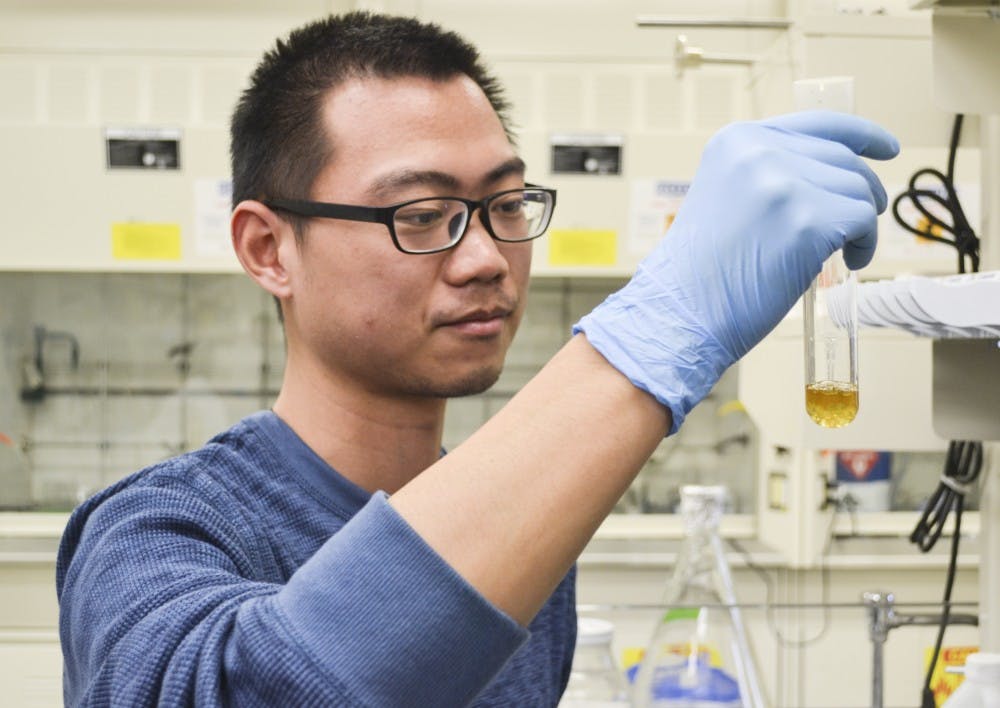In the Department of Chemistry and Chemical Biology, the lab of Assistant Professor Dr. Charles Melancon has engineered a potential new screening process for the characterization of these anti-bacterial drugs.
The type of natural products Melancon and his team study are small molecules produced, as their name suggests, naturally by certain microbes. Many, such as erythromycin and tetracycline, evolved to serve as chemical weapons against predators and/or competing organisms, making them effective antibiotics.
“Nature gives us much more than we know,” said Xuechen Zhu, a graduate student in Melancon’s lab. “Approximately 65 percent of all drugs are natural products and their derivatives.”
Scientists are constantly screening and testing natural products to find new drugs to replace old ones to which bacterial strains have become resistant.
“The process, however, can be arduous and extremely time-consuming,” Melancon said.
In an effort to streamline this process, Melancon and one of his graduate students, Shijie Huang, developed a way to examine several important steps of the natural product characterization process, such as efficacy, potency and function - all in a matter of hours, he said.
“[It started as] one of these kind of harebrained ideas that I had no idea if it was going to work,” Melancon said. “What we’ve done is we’ve made a highly engineered E. coli strain that is capable of sensing a particular class of natural products and outputting a fluorescent signal when they are present.”
In this method, the natural product being tested is simply mixed in with the mutant E. coli and incubated overnight.
He said an effective drug would cause the bacteria to glow bright green, while the dose at which this occurs gives information on both the potency and the mechanism by which it works.
“At the outset when we built it we were not sure how good it was going to be, but what we hoped for, and actually it looks like it is true, is that the intensity of the fluorescent signal correlates with the potency of the compound,” Melancon said.
The result is a completely novel method for screening certain antibiotics.
Get content from The Daily Lobo delivered to your inbox
“No one else in the world has developed a system quite like this,” he said.
The system works by harnessing the normal actions of the natural products, Melancon explained.
“When a cell divides, a molecular machine known as the ribosome is responsible for reading the genome and using it to make copies of all the proteins in that cell, so that each new cell will have a complete set. More than 50 percent of anti-bacterial drugs work by inhibiting the ribosome, which is why most antibiotics only work in dividing cells,” he said.
Melancon and his lab work with a mutated version of E. coli that produces a protein that glows green, he said.
“To this E. coli we added a mutated ribosome that, under normal circumstances, specifically makes a protein that shuts off the green fluorescence,” he said. “However, if the E. coli is treated with an antibiotic that blocks ribosome function, it will be unable to make the protein that turns off the cell’s fluorescence and the E. coli will glow.”
The system developed by Melancon and his students has several advantages over typical screening processes, Huang said.
“Our system can not only sense the molecule but also study its inhibition mechanisms,” Huang said. “Besides, our system is a whole cell sensor, which provides an authentic environment for the drug to bind and react.”
Huang said he has been working on this project for two and a half years, at first with little success.
“It was hard for me at the beginning and we almost thought it would not work out and [were] ready to give up [on] the project at a time. It was lucky for us to overcome the bottleneck and eventually make the system work,” said Huang. “It is fun for me to build different synthetic gene circuits and put them together to make the cell behave as we want.”
Melancon expressed a similar enthusiasm for hijacking and programming normal cell function.
“I have always been interested in making sensors for things,” Melancon said. “We do it all using engineered cells. I find it really gratifying to be able to program cells to do useful things.”
Melancon and his lab, in addition to the development of this system, have a hand in nearly every aspect of natural product investigation from developing software to screen large databases for new drugs to sequencing samples taken from microbes living deep in the caves of southern New Mexico, he said.
“Projects going on in our lab are promising, not only due to the academic significance in natural product pathway studies, also because we are studying issues related to practical pharmaceutical production,” Zhu said.
Lauren Topper is a freelance reporter with the Daily Lobo. She can be contacted at news@dailylobo.com, or on Twitter @DailyLobo.






